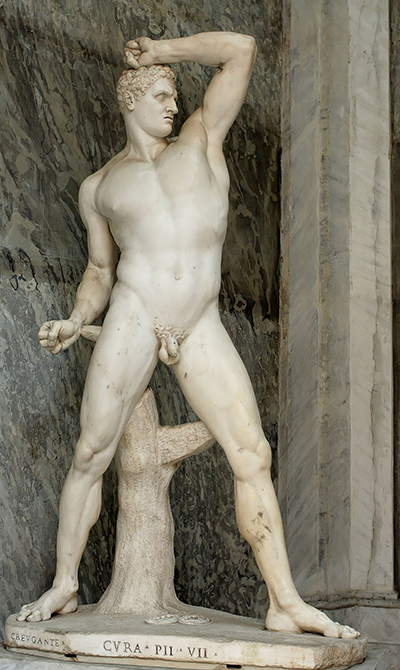 Buy Art Prints Now
Buy Art Prints Nowfrom Amazon
* As an Amazon Associate, and partner with Google Adsense and Ezoic, I earn from qualifying purchases.
Creugas remains today in several different versions, with the Museum Gipsoteca Antonio Canova in Possagno, Italy hosting a plaster version from around 1794/1796. The posture of this sculpture boasts strength and confidence, with the subject being a pugilist or boxer from ancient Greece.
The stance is intended to intimidate, as the figure proclaims his strength and readiness for battle. His left arm is lifted up to exaggerate his height, whilst his right hand is clenched into a fist. Bronze versions of this and another sculpture, Damoxenos, have been discovered but these are believed to have been produced after Canova's lifetime, making their valuations much lower. Damoxenos himself was also a fighter and the angle of that statue suggests that perhaps these two items were intended to be displayed together, in opposing directions. Several marble versions of the two have also been produced since the artist put the originals together, and they vary in size. The original marble works of Creugas and Damoxenos now stand in the Vatican, either side of Perseus Triumphant (with Head of Medusa), providing a powerful trio of sculptures by this highly regarded Italian artist. Much of the sculptor's original works remain within what we now refer to as Italy, though during his own lifetime was a collection of provincial states with their own autonomy and regional governments.
The marble versions can now be found in the Octagonal Courtyard of the Vatican Museums.The sculptor would study ancient literature and history, which gave him a number of themes that would provide the inspiration for different paintings and sculptures. Creugas of Durres and Damoxenos of Syracuse would therefore inspire two different sculptures, and the story that he would have come across tells of how each would allow the other to strike them whilst undefended. They would naturally aim for their opponent's head, hoping to sustain more damage from the single shot than they received in return. This method of battle is very different to modern boxing, where there is an art to hitting and not being hit in return. The story tells of how Creugas died from his wounds, and this led to him being awarded the winner. This method of battle seems strange today but tells of heroism and strength, a brutality that thankfully is not often seen in modern sport.
The overall project took several years from conception to completion. The drawings were produced in around 1795, whilst the large marble sculptures were finally completed in around 1801 (Creugas) and 1806 (Damoxenos). There was then many alternative interpretations of these two sculptures by other artists across the 19th century, some of whom would have been strongly connected to Canova, perhaps even serving under him at some point. Creugas's posture is of someone bracing for an assault, hoping to minimise the damage by leaning away from the attacker. Sadly, as the story goes, these attempts would be in vain, and he would pass away soon after the short lived fight. The sculptures were an attempt to replenish the collection of the Vatican soon after it had effectively been looted by the French army several years earlier. The two nations would compete for several centuries through the desire to host the finest art and had few challenges elsewhere at the time.




